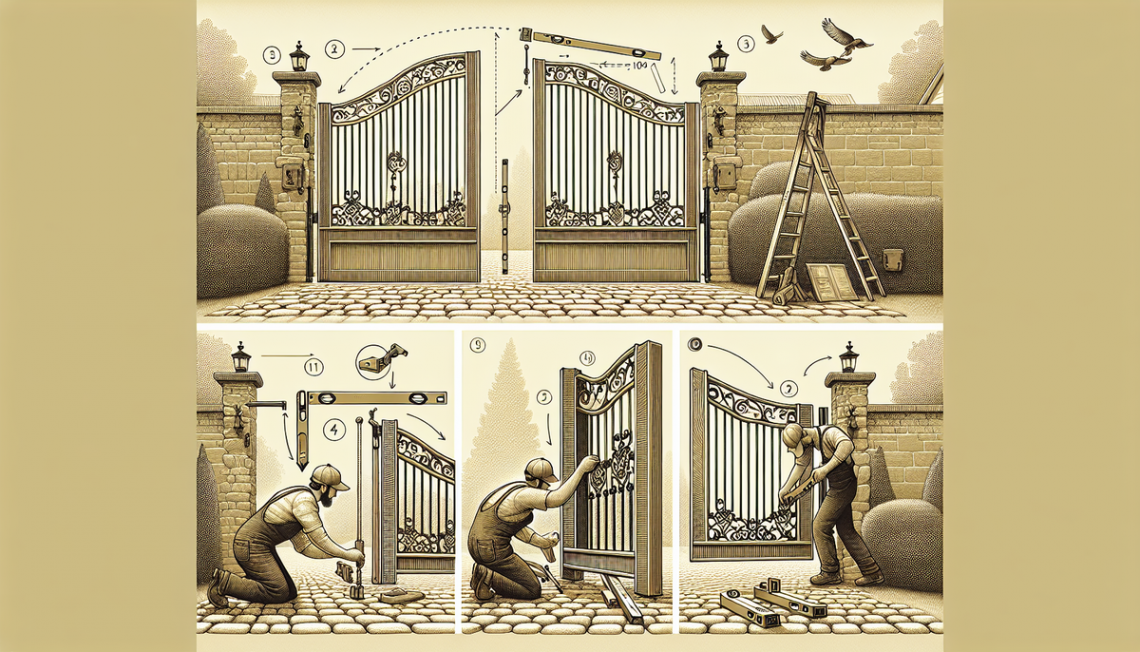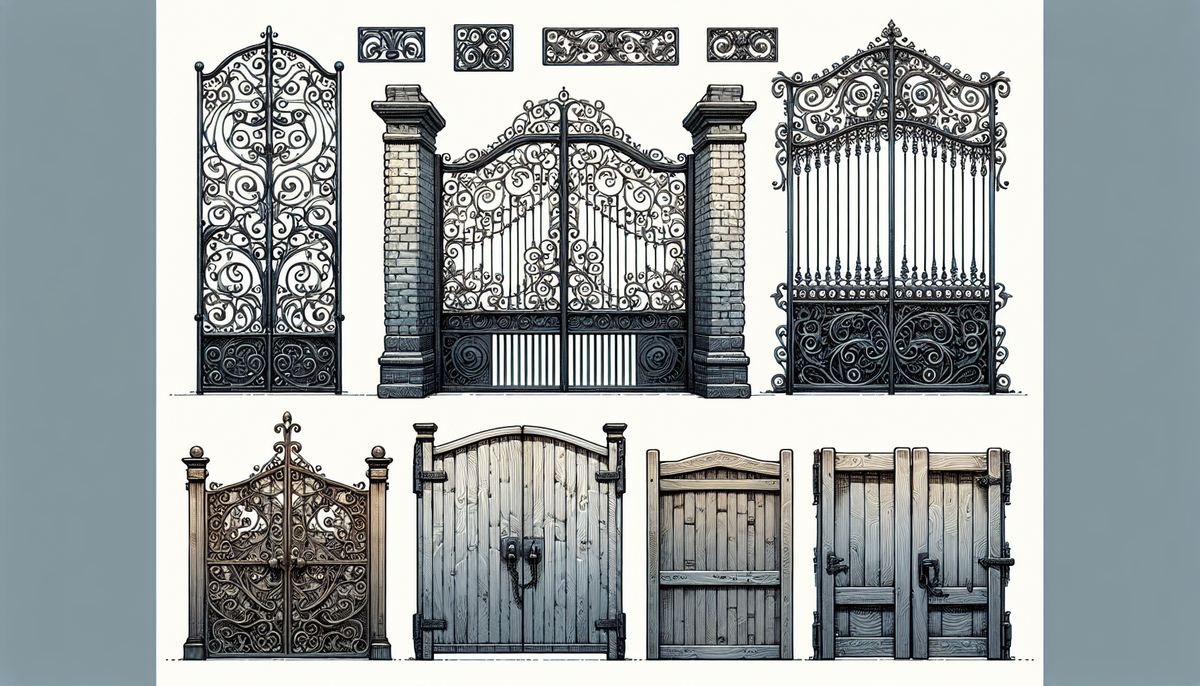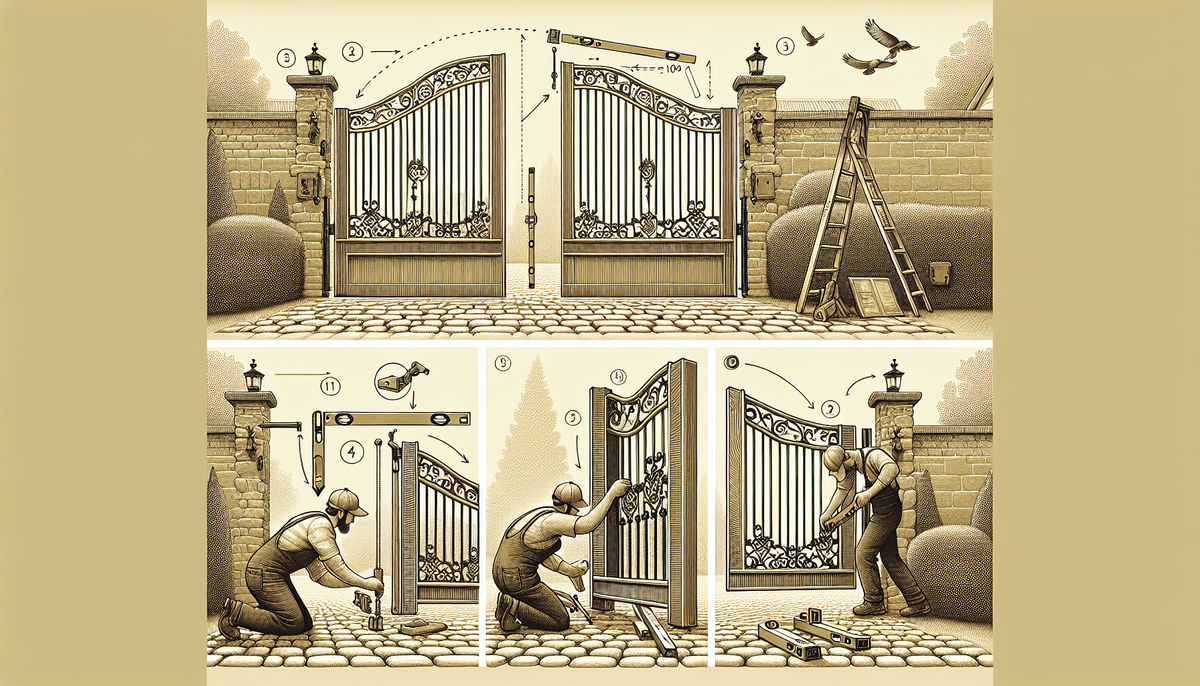What Is A Swing Gate & How Do They Work?

Curious about “what is a swing gate”? Simply put, it’s a moveable barrier that opens by swinging on hinges, creating an entryway in a fence line. They range from manually operated to the automatic, sophisticated systems you can activate with the push of a button. Through this article, we’ll break down their designs, functionalities, advantages, and how they stack up against other gating options—all without burying you in jargon right from the start.
Key Takeaways
-
Swing gates add aesthetic appeal and security to properties, with choices between single or double-leaf, inward or outward openings, made from various materials and customised with different finishes.
-
Installing a swing gate can increase property value, enhance security, and reduce insurance premiums, while choices between manual and automatic systems offer convenience and advanced safety features.
-
Preparation for swing gate installation requires careful consideration of space, levelling, and pillar strength, while automation involves intricate wiring and offers multiple safety features and access control options.
Defining Swing Gates: Types and Functions
Swing gates stand as sentinels at the entrances of homes and businesses, offering both an aesthetic touch and a formidable barrier. These gates are renowned for their straightforward installation, appealing design and colour, and a plethora of models tailored for different entrance specifications. Whether crafted from sturdy metals like aluminium and steel or the timeless beauty of wood and vinyl, swing gates come in single or double-leaf variants to accommodate any approach.
Each material, including metal, imparts its own unique durability and visual charm. Combined with other surface finishes such as powder coating, painting, or anodising, these enhance the gate’s resilience and visual impact.
Inward Opening vs Outward Opening
While the gentle arc of a swing gate exudes elegance, the choice between fitting an inward or outward opening gate hinges on both preference and practicality. Inward-opening gates are the norm, especially in urban settings where pavement clearance is considered. However, if your property allows, gates that open outwards might be your pick, particularly to utilise space more efficiently or for a dramatic flourish.
Bear in mind that swinging gates are not immune to nature’s whims; gusty conditions can exert undue stress on their mechanisms, a factor worth considering in windy locales. Visitors should note the potential impact of weather on the gates’ durability and functionality.
Manual vs Automatic Swing Gates

The evolution from manual to automatic swing gates has been a game-changer regarding convenience and security. The effortless glide of an automatic gate as it swings open, whether by remote control or pre-set automation, adds a layer of sophistication to your driveway entry. With advanced control boards, your automatic swing gate can adopt various operating modes—welcoming guests, ensuring high security, or facilitating maintenance tasks.
Besides, the automated finesse of opening heavy gates not only deters intruders but also preserves the gate’s integrity with features like ‘soft-opening/soft stop’ and customisable safety sensor settings.
The Benefits of Installing a Swing Gate

The installation of a swing gate offers several benefits:
-
It enhances the market value of your property, adding sophistication and appeal.
-
It improves the security of your home.
-
Some insurance providers may offer lower premiums for homes with swing gates.
Swing gates, with their myriad of design options, allow homeowners to choose a gate that not only secures but also complements their property’s aesthetic. It’s a true confluence of elegance, security, and financial prudence, with the added benefit of possibly reduced insurance costs due to the enhanced security features of fencing.
Swing Gate vs Sliding Gate: Choosing the Right Option
When it comes to deciding between a swing gate and a sliding gate, space is the defining parameter. Swing gates require ample operating room, making them less suitable for compact driveways. On the flip side, sliding gates glide parallel to the fence line, an ideal choice for properties where space is premium or sloped terrains complicate the swing open motion.
Moreover, if your driveway leads immediately into a sharp turn, sliding gates can accommodate this layout more gracefully than their swinging counterparts.
Yet, for those drawn to the allure of swing gates, the rewards include:
-
cost-effectiveness due to simpler mechanics
-
reduced maintenance owing to fewer moving parts
-
a quieter operation that ensures your comings and goings are as discreet as they are secure.
But don’t discount security; sliding gates often rank higher on this front, as they are more challenging to force open compared to swing gates.
Preparing for Swing Gate Installation
A meticulous preparation phase is paramount before the grand unveiling of your swing gate. Initiating with a site check to guarantee no obstructions and sufficient clearance, this phase sets the stage for a smooth operation, whether your gate is designed to open inward or outward. The pillars, those unsung heroes of stability, must be plumb and robust enough to support the gate’s weight without impairing its graceful movement.
Ensuring the ground is level is of equal importance, as any slope or irregularities could spell trouble for the gate’s functionality. Don’t forget to navigate the landscape of local regulations, as planning permissions may be a requisite, particularly within conservation zones.
Pillar Strength and Stability
The gate’s pillars are the linchpins of its stability and functionality. These vertical sentries of metal must be square and strong, a testament to their ability to bear the gate’s weight and facilitate its movement, all while being constructed as one piece.
A straight-edged measure from the ground and a diagonal check from the base will confirm the pillars’ squareness, ensuring they stand firm and true.
Ground Leveling and Slope Considerations
Sloping terrains require special attention during a swing gate’s installation. If the gate’s path slopes upward from the road, rising hinges or an outward-opening design may be necessary to navigate the incline. These uphill hinges allow the gate to ascend gracefully, ensuring the slope doesn’t hinder its operation.
Step-by-Step Guide to Swing Gate Installation

Embarking on the journey to install a swing gate is akin to crafting a masterpiece—it demands precision, patience, and the right tools. The installer must possess skills such as using a spirit level for perfect alignment, taking precise measurements, and drilling to ensure a secure fit.
The hardware, including hinges, handles, drop bolts, and latch, must be meticulously attached, ensuring the swing gate operates flawlessly.
Tools and Equipment Required
The artisan’s toolkit for swing gate installation includes:
-
Hand tools like shovels, hammers, and screwdrivers for excavation and assembly
-
Power tools such as drills and saws for creating pilot holes and sizing materials
-
Levels and tape measures for accuracy and precision
These tools are vital for a successful swing gate installation.
A supplied spanner set completes the ensemble, tightening and securing the gate’s components for a steadfast installation.
Time and Manpower Considerations
Time is of the essence when installing a swing gate, with a typical setup requiring between 4 to 8 hours. It’s not a solo mission—two people are generally recommended to manage the materials and ensure the gate’s proper alignment and attachment.
Automating Your Swing Gate: Wiring and Access Control

In the age of convenience, automating your swing gate is a logical step forward. This process involves a symphony of wiring configurations, from powering the control box to connecting safety and access control components. Moreover, automation comes with a suite of safety features, from impact-detecting edges to non-contact sensors, ensuring that your swing gate is as safe as it is smart.
Power Supply and Safety Features
Ensuring a reliable power supply and implementing safety sensors are foundational to the smooth operation of an automated swing gate. Strategic placement of photo eyes and lasers can avert accidents by identifying entrapment zones. Non-contact safety beams provide additional protection, detecting any obstructions and preventing untimely contact with the moving gate.
Proper, resilient wiring is crucial to withstand environmental factors and wear, while additional security features like automated locks reinforce the gate against unauthorised access. Childsafe functions and delay features are also integral to the gate’s safety and user-friendliness.
Visitor Access Methods
The modern automated swing gate comes complete with an array of visitor access options, including:
-
Control panels
-
Radar
-
Overhead sensors
-
Remote controls
These are just a few sophisticated methods available to manage entry and exit.
For existing vehicles, the simplicity of a press button or the technology of an in-ground vehicle detector can facilitate a seamless departure.
Summary
Ultimately, a swing gate is more than a gateway; it’s a fusion of form and function, offering aesthetic appeal and fortified security. Whether manual or automated, these gates stand as a testament to the ingenuity of modern design and engineering. From the materials chosen to the installation process, each step is a building block toward achieving a seamless and secure entrance to your abode. Let your swing gate be an emblem of your commitment to both style and safety.
Frequently Asked Questions
What is the difference between a swing and a sliding gate?
The main difference between swing and sliding gates is that sliding gates slide in and out while swinging gates open and close automatically in a wide half-circle. Sliding gates are great for limited space and rough ground.
What is a swing gate at an airport?
A swing gate installed at an airport can handle both domestic and international flights, maximising capacity and accommodating arriving passengers without constructing new gates.
How does a swing gate work?
A swing gate is powered by an electric motor called the gate operator. This motor converts electrical energy into mechanical motion to open and close the gate efficiently.
What is the function of the swing gate?
Swing gates operate automatically with the assistance of swing gate operators, reducing the necessity for manual manipulation, and are commonly used in shared facilities such as airport terminals.
What are the main benefits of installing an automatic swing gate?
Installing an automatic swing gate can increase your property's value, enhance aesthetics, improve security, and potentially lower insurance premiums.
- Tagged as:
- Swing Gates


